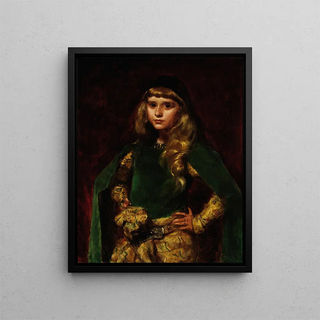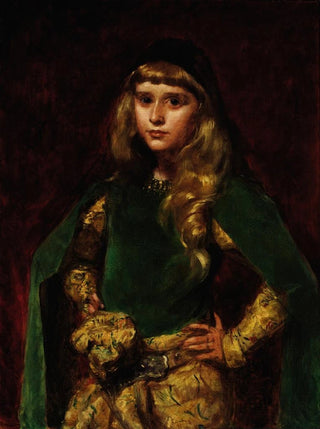Painting Natalie at ten years old - Carolus-Duran | Art print


View from behind

Frame (optional)
In the world of art, some works manage to transcend time and capture the very essence of innocence and beauty. "Natalie at ten years old" by Carolus-Duran is one of those creations that, through its delicacy and striking realism, transports us into a universe of a childhood full of promise. This portrait, created in 1881, subtly reveals the features of a young girl, Natalie, whose gaze, both dreamy and mischievous, seems to invite us to share a privileged moment of her life. Through this artwork, Duran does not merely depict a child; he immortalizes an emotion, an atmosphere, and reminds us of the fragility and beauty of childhood.
Style and uniqueness of the work
Carolus-Duran, master of portraiture, stands out for his unique approach that combines realism and romanticism. In "Natalie at ten years old," the chiaroscuro technique is used brilliantly, playing with lights and shadows to bring the figure of the child to life. Natalie's face, delicately illuminated, is surrounded by a darker background that emphasizes her presence. The texture of the clothing, carefully rendered, evokes the richness of fabrics from the era, while subtle details, such as the delicate strands of hair framing her face, demonstrate the attention to detail. This portrait, far from being a simple representation, becomes a true window into the soul of the young girl, revealing an emotional depth that captivates the viewer.
The artist and his influence
Carolus-Duran, born in 1837, established himself as one of the most prominent portraitists of his time. Influenced by the masters of the past, he developed a personal style that blends tradition and modernity. Duran trained many artists, some of whom would become emblematic figures of the Impressionist movement. His approach to portrait painting, which favors spontaneity and individual expression, paved the way for a new way of conceiving human representation. Through "Natalie at ten years old," one perceives this desire to capture not only appearance but also the very essence

Matte finish

View from behind

Frame (optional)
In the world of art, some works manage to transcend time and capture the very essence of innocence and beauty. "Natalie at ten years old" by Carolus-Duran is one of those creations that, through its delicacy and striking realism, transports us into a universe of a childhood full of promise. This portrait, created in 1881, subtly reveals the features of a young girl, Natalie, whose gaze, both dreamy and mischievous, seems to invite us to share a privileged moment of her life. Through this artwork, Duran does not merely depict a child; he immortalizes an emotion, an atmosphere, and reminds us of the fragility and beauty of childhood.
Style and uniqueness of the work
Carolus-Duran, master of portraiture, stands out for his unique approach that combines realism and romanticism. In "Natalie at ten years old," the chiaroscuro technique is used brilliantly, playing with lights and shadows to bring the figure of the child to life. Natalie's face, delicately illuminated, is surrounded by a darker background that emphasizes her presence. The texture of the clothing, carefully rendered, evokes the richness of fabrics from the era, while subtle details, such as the delicate strands of hair framing her face, demonstrate the attention to detail. This portrait, far from being a simple representation, becomes a true window into the soul of the young girl, revealing an emotional depth that captivates the viewer.
The artist and his influence
Carolus-Duran, born in 1837, established himself as one of the most prominent portraitists of his time. Influenced by the masters of the past, he developed a personal style that blends tradition and modernity. Duran trained many artists, some of whom would become emblematic figures of the Impressionist movement. His approach to portrait painting, which favors spontaneity and individual expression, paved the way for a new way of conceiving human representation. Through "Natalie at ten years old," one perceives this desire to capture not only appearance but also the very essence
12,34 €






